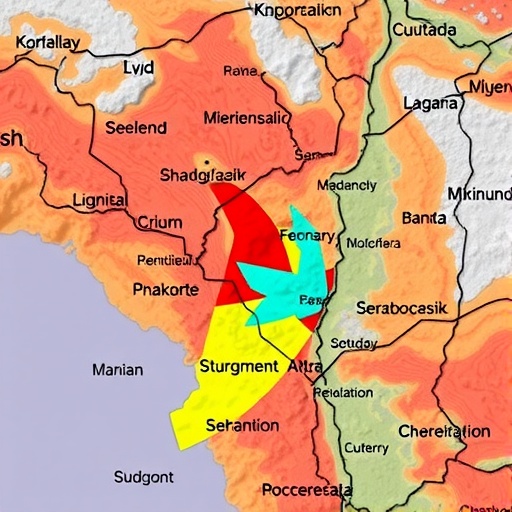In March 2025, Myanmar experienced a monumental seismic event that has since captivated the earth science community due to its unprecedented scale, speed, and mechanics. The magnitude 7.8 Mandalay earthquake ripped through nearly 500 kilometers of the Sagaing Fault—a major continental strike-slip fault—at velocities previously rarely documented. This seismic rupture not only extended over a vast distance but also maintained supershear rupture speeds, traveling faster than the shear waves typically emitted during such events. This discovery is transformative, offering fresh insights into the physical behavior of continental fault systems and their potential seismic hazards.
The Sagaing Fault, a critical tectonic boundary running through Myanmar, is characterized by its relative simplicity and linear geometry, qualities that are conducive to focused energy release during ruptures. The March 2025 rupture broke a 250-kilometer segment that had been locked and quiescent for over a century, triggering a surface rupture exceeding 450 kilometers in length. This event is distinguished not simply by its size but by the extreme rupture propagation speed, reaching about 5.3 kilometers per second—far beyond the standard shear-wave velocity in continental crust. Such supershear ruptures demonstrate a rupture front that outpaces the seismic waves, thereby potentially magnifying the destructive power on the surface.
The key to understanding this extraordinary rupture lies in the detailed multidisciplinary study led by Shengji Wei and colleagues, which integrated satellite geodesy, broadband seismic analysis, receiver function imaging, and advanced numerical simulations. This comprehensive approach enabled the researchers to reconstruct the earthquake’s three-dimensional surface deformation pattern, slip distribution, and dynamic rupture process with precision. One striking finding was the rupture’s bidirectional propagation from the epicenter, which, after an initial phase, switched to a sustained supershear regime particularly toward the south.
Beneath this rupture behavior is the presence of an unusually thick, low-velocity fault zone roughly two kilometers wide—an anomaly compared to more brittle, narrow fault zones commonly observed in strike-slip domains. Within this fault zone, the shear-wave speeds were diminished by approximately 45%, indicating a significantly altered mechanical property likely due to accumulated damage and fracturing over repeated seismic cycles. This attenuation of seismic velocity is not merely a passive characteristic but serves to channel and maintain the supershear rupture by promoting energy concentration along a simplified fault structure.
This thick, low-velocity fault zone likely represents a damage zone, a region of distributed microfracturing and granular disruption, born from prior earthquake activity. The presence of such a fault zone can drastically influence rupture dynamics by dissipating energy differently and altering stress conditions ahead of the rupture front. In the Mandalay earthquake case, these physical properties fostered an environment conducive to both initiating and sustaining rupture velocities greater than the shear wave speeds, a phenomenon rarely documented over such extensive fault lengths.
The implications of these findings extend far beyond Myanmar’s borders. The recognition that wide, low-velocity fault zones can sustain supershear ruptures provides critical insights for seismic hazard assessment around the globe, particularly for other major continental strike-slip systems possessing similar geological characteristics. The San Andreas Fault in California and the North Anatolian Fault in Turkey are prominent examples where long, straight fault segments intersect thick fault damage zones. Understanding their rupture potential through this lens could refine risk models and prepare affected regions for future high-impact seismic events.
Furthermore, this research challenges classic rupture models that often treat faults as thin, brittle interfaces, highlighting the importance of incorporating fault zone complexity into rupture dynamics studies. By acknowledging the variability of fault zone thickness, velocity structure, and damage evolution, seismologists can better predict rupture behavior and its surface expression. The Mandalay earthquake exemplifies how fault zone properties can directly modulate rupture propagation speed and extent, essential factors in seismic hazard forecasting.
The sustained supershear rupture along the Sagaing Fault also calls attention to the underappreciated role of fault geometry and internal structure in influencing rupture speed transitions. The transition to supershear velocities occurred approximately 100 kilometers south of the epicenter, coinciding with a marked change in the fault’s structural characteristics. This suggests that subsurface features and the fault’s mechanical evolution critically control rupture acceleration and propagation, beyond traditional measures of stress and slip potential.
Moreover, the detailed characterization of the rupture’s slip distribution reveals heterogeneous energy release, with localized slip patches and variable displacement rates, underscoring the complexity of supershear rupture mechanics. Numerical simulations replicating these features allowed the research team to validate proposed mechanisms and refine theoretical frameworks governing fault rupture behavior. Such simulations are increasingly vital in bridging observational gaps, enabling the assessment of scenarios impossible to directly observe.
The March 28, 2025 Mandalay earthquake hence stands as a paradigmatic example of how modern interdisciplinary seismology can decode the nuanced interplay between fault zone structure and rupture dynamics. The lessons learned from this event are instrumental for advancing earthquake science, illustrating that supershear ruptures are not only artifacts of specific fault geometries but are deeply influenced by mechanical and velocity contrasts within the fault zone itself. This knowledge enhances predictive capability, crucial for disaster preparedness in seismically active continental regions.
In conclusion, the study of the 2025 Mandalay earthquake underscores a paradigm shift in understanding continental rupture mechanics, particularly in the context of supershear velocity transitions sustained over hundreds of kilometers. The thick, low-velocity Sagaing fault zone acted as a natural conduit enabling the longest and one of the fastest recorded continental ruptures, reshaping how geoscientists conceptualize and model seismic hazard in complex fault systems worldwide. Continued investigation into fault zone architecture and its impact on rupture dynamics promises to yield ever more refined insights into the seismic processes shaping our planet.
Subject of Research: Dynamics of supershear ruptures and fault zone properties in continental strike-slip earthquakes
Article Title: Supershear rupture sustained through a thick fault zone in the 2025 Mw 7.8 Mandalay earthquake
News Publication Date: 30-Oct-2025
Web References: 10.1126/science.adz2101
Keywords: Supershear rupture, Sagaing Fault, Mandalay earthquake, strike-slip fault, rupture dynamics, low-velocity fault zone, continental earthquakes, seismic hazard, shear-wave velocity, fault damage zone, rupture propagation, earthquake physics




